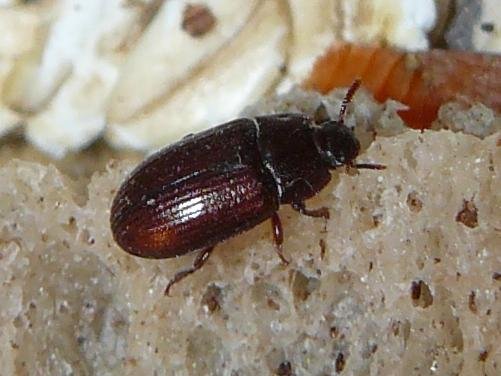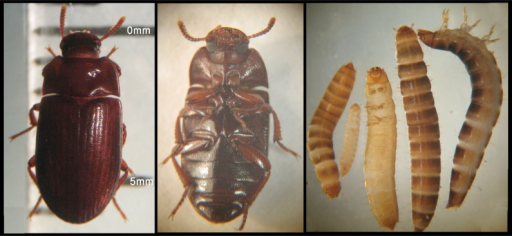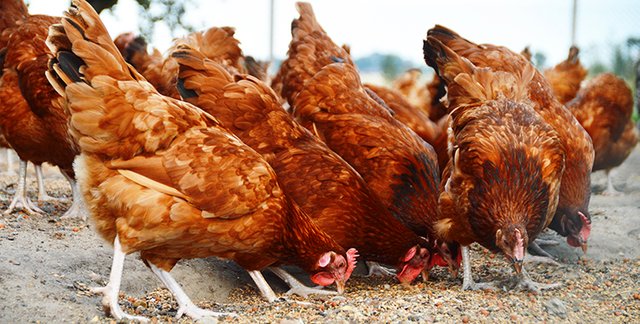THEME WEEK - FARM PESTS: The beetles: Alphitobius diaperinus
Hello dear community of @farms, @steemchurch, today in THEME WEEK - FARM PESTS: The beetles: Alphitobius diaperinus

source
The beetle Alphitobius diaperinus, commonly called by different names such as: bed beetle, grain beetle, barn shelduck, black beetle, dung beetle, is native to the African continent but has spread to other continents as is the case Europe.
This beetle is one of the most common pests in poultry farms and causes different damages-
The Taxonomic classification is the following: Kingdom: Animal; Class: Insecta; Order: Coleoptera; Family: Tenebrionidae; Species: Alphitobious diaperinus.

source>
Biological cycle:
The Alphitobius diaperinus has a long longevity can live more than a year in the wild and under experimental conditions to reach two years, in addition its high reproduction power makes this beetle in a short period of time to increase its population in a more how remarkable
The females lie in the organic material (bed), in the cracks of the insulating materials of the poultry houses, even in cracks in the ground, laying 3 to 5 eggs a day, being able to put an amount of 2000 eggs during his life . Its incubation period is between 3 to 9 days from where it leaves the larva that passes through six stages, the larvae eat practically everything, organic matter, cereals, even larvae of the same species (cannibalism), insulating materials, finally the larva pupa hatch the beetle. Its biological cycle lasts on average about 42 days under optimal conditions.
How is it possible that there is a large population of Alphitobius diaperinus, if the biological cycle of this beetle lasts approx. 42 days and the chickens are usually in farm about 45 - 48 days?
This is because at the time of emptying the ship, the bed is cooled and the population of Alphitobius migrates to warmer areas, such as reservoirs in the insulating walls or even outside the ships to be buried in the ground.
Once the ship is heated to accommodate a new herd of chickens these adult Alphitobius return to the ship or leave their reservoirs and begin to lay eggs.
Also, if a good disinfection has not been done, larvae and pupae may survive.
So at the beginning of a litter can come together different larval stages of this beetle, adults, larvae or pupae.
As the logician, at the beginning of the breeding of chicken there will be more adult population, about 15-20 days of breeding more population of larvae and when it is time to remove the chickens there will be a larger population of adults.

source
DAMAGE
Mainly the Alphitobius diaperinus originate three damages:
Transmission of diseases: it is a very important vector of diseases such as Marek, Salmonella, Gumboro .
Damage to the facilities: They can perforate insulating materials with the consequent loss of thermal efficiency of the ship.
Damage to birds: direct action on birds, which causes them great stress, losing technical performance, and can cause lesions that facilitate the entry of pathogens into the bird's organism, as previously mentioned.
Finally, it must be borne in mind that it can also cause damage to personnel working in these facilities.
CONTROL
For the control of these pests, the use of chemical products (pyrethroid substances) is the most used, having different brands in the market, which differ mainly by their range of action.
There are three ranges of action: those that affect only larvae, those that affect adults and those that affect larvae and adults.
The control for adults is done days before the emptying of the ship and during the sanitary vacuum, and generally it is spraying the bed and ship with said products; and for larvae control is done once the chickens are housed in the ship by spraying the ship or specific parts of the ship where the population of Alphitobius diaperinus is greater than it can be under the feeders.
Finally, I have already said that there is a wide variety of products on the market with its specific range of action, as well as the period of application, dosage, ...., So I think it is not interesting to comment, but simply to have an idea of how this plague is controlled.
The period of the year where the population of these animals is most abundant is in the spring, so this plague will have to be controlled very well especially in the spring pollada.
Dear friend, you do not appear to be following @wafrica. Follow @wafrica to get a valuable upvote on your quality post!
Ready!! Now I am your follower, thank you for commenting.